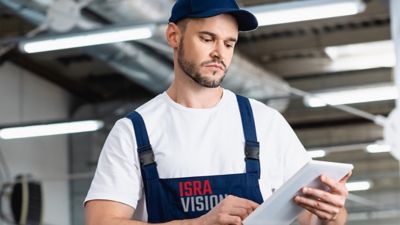평판 디스플레이(FPD) 유리의 완벽한 품질 보장
평판 디스플레이 (FPD)는 최신 전자 기기에서 어디에나 존재합니다. 생산에는 여러가지 중요한 단계가 포함되며 각 단계는 최종 제품의 품질과 신뢰성에 결정적인 역할을 합니다.
생산의 모든 단계에서 ISRA VISION의 자동 검사 시스템은 품질 기준을 충족하는 완벽한 유리만 고객에게 전달할 수 있도록 보장합니다.
글라스 리본 (ribbon) 검사
마이크로미터 정밀도로 얇은 유리 검사 벤치마크
얇은 유리를 생산하는 동안 유리 리본은 고품질 제품 생산을 보장하기 위해 여러 검사 단계를 거칩니다. 광학 검사 시스템은 이 공정의 필수적인 부분으로, 일반적인 결함은 물론 10µm의 작은 스레드까지 실시간으로 자동 감지할 수 있습니다.
플로트 유리의 얇은 유리 검사를 위해 특별히 설계된 이 시스템은 Multi-view 이미징과 Dynamic Moiré 특허 기술, 전환 가능한 고출력 LED 조명과 같은 첨단 기술을 사용하여 최적의 결함 감지 및 광학적 왜곡에 대한 감도를 달성합니다.
결함이 감지되면 시스템은 자동으로 담당자에게 피드백을 제공하고 결함의 심각도, 크기, 유형 및 위치에 따라 결함을 분류합니다. 이를 통해 문제를 신속하게 대응하고 수정할 수 있어 생산 중단 시간과 비용을 줄일 수 있습니다. 또한 시스템에서 수집한 종합적인 결함 데이터를 통해 빠르고 쉽게 근본 원인을 분석할 수 있어 유리 제조 공정을 지속적으로 최적화할 수 있습니다.
이점
- 모든 관련 결함을 안정적으로 감지
- 유형, 크기, 심각도에 따라 모든 발견 사항을 자동 분류
- 특허받은 Cross Dark Field 조명을 사용하여 미세 스크래치와 core 기포까지 감지
- 결함 유형, 크기, 위치에 대한 실시간 피드백 제공
- 전체 유리 리본의 굴절력을 모니터링하고 중요한 광선을 감지하며 Zebra 각도 모니터링
- 전송 채널을 사용하여 Core 크기를 정밀하게 측정하고 반사 채널을 통해 결함 깊이를 측정
- Features
- Typical defects
- Technical data
- 최대 10µm의 코드 감지
- 굴절력 모니터링을 위한 특허 받은 고유한Dynamic Moiré기술
- 첨단 공기 쿨링 시스템을 통한 강력한 냉각
- Multi-view 이미징 및Dynamic Moiré 특허 기술
- 기포, 결정성 물질, 매듭
- 상단 또는 하단 주석
- 스크래치, 줄무늬, 크랙
- 오염
- 엣지 결함
- 휨 (Warpage)
- 30µm의 광학 해상도
- 최대 8개의 광학 채널로 고급 감지 성능
- 광선 감지 및 측정을 위한 특허 채널(reams, Zebra,..., ....)
- 최대 10µm의 코드 감지
판 유리 검사

얇은 유리판 (thin glass) 생산의 모든 단계에서 다양한 첨단 검사 시스템이 품질 보증에 중요한 역할을 합니다.
고정밀 엣지 검사와 지속적인 공정 최적화
특수 설계된 시스템은 다중 조명 채널과 고해상도 카메라를 사용하여 얇은 유리 기판의 엣지를 검사합니다. 이 시스템은 유리 엣지를 180°로 볼 수 있어 연삭 편차를 감지하고 연삭 공정 개선에 중요한 데이터를 제공합니다. 또한 칩, 크랙, 광택, 번 마크, 비대칭과 같은 모든 일반적인 엣지 결함을 안정적으로 분류하여 신뢰할 수 있는 품질 평가를 보장합니다.
3-in-1 솔루션으로 클린룸 품질로 완벽한 얇은 유리 기판 검사 보장
또 다른 광학 검사 시스템은 최대 세 가지 검사 작업을 결합하여 얇은 유리 기판의 표면을 검사합니다. 이 과정에서 이 시스템은 아주 작은 유리 및 표면 결함도 안정적으로 감지하고 분류합니다. 동시에 방향에 관계없이 아주 작은 스크래치도 감지합니다. 마지막으로, 클린룸 품질 모니터링을 위해 입자 계수 시스템은 마이크로미터 범위까지 모든 입자를 감지하고 크기별로 분류하여 입자 분포에 대한 통계 분석을 제공합니다. 따라서 클린룸 품질 모니터링 및 청소 프로세스 최적화를 위한 신뢰할 수 있는 데이터를 제공합니다.
현미경 분석을 통한 신뢰할 수 있는 품질 분류
아주 작은 결함도 신뢰할 수 있는 품질 분류를 보장하기 위해 자동 현미경을 사용하여 검출된 결함을 더 자세히 분석합니다. 고해상도 현미경 이미지를 사용하여 결함 분류를 다시 한 번 확인하고, 결함의 크기를 정밀하게 측정하고 유리 내 위치를 파악합니다. 수집된 정확한 정보를 통해 추가 가공 또는 납품을 위한 사양을 충족하는 유리판을 확실하게 분류할 수 있습니다.
이점
- 3-in-1으로 공간 및 운영 비용 절감
- 다목적 시스템과 짧은 라인 길이로 비용 및 유지보수 effort 감소
- 최단 시간 내에 투자 수익 달성(ROI) 특징
- Features
- Typical defects
- Technical data
- 결함 검사: 최대 15kLux의 고급 스크래치 감지
- 엣지 검사: 4개의 모든 엣지와 코너 품질 관리
- 입자 계수: 상단 및 하단 검사
- 검토: 정확한 크기 정보 및 결함 깊이 측정
- 미크론 이하 입자
- 미세 스크래치
- 쉘, 연삭 결함, 코너
- 내포물, 기포, 백금
- 스톤, 니들 팁, 얼룩, 컬렛
- 광학 해상도
- 검사: 15 µm/px
- 입자: 10.5 µm/px 또는 21 µm/px
- 1µm 이하의 입자 감지
- 조명:
- 왜곡 채널: 광학 및 희미함
- 브라이트 필드 투과
- 크로스 다크 필드
- 반사 다크 필드
다운로드

Brochure FPM-Master [EN]
- Filename
- brochure-flatpanelmaster-glass-en.pdf
- Size
- 805 KB
- Format

Brochure FPM-Master [CN]
- Filename
- brochure-flatpanelmaster-glass-cn.pdf
- Size
- 902 KB
- Format

Brochure FPM-Master [KO]
- Filename
- brochure-flatpanelmaster-glass-ko.pdf
- Size
- 914 KB
- Format
소형 포맷 글라스 검사

소형 형태의 유리는 스마트폰 디스플레이, 헤드업 디스플레이, 굴절 미러 및 차량 디스플레이와 같은 첨단 제품에 사용됩니다. 생산 과정에서 사이즈나 형태의 불일치, 유리나 표면의 결함, 불완전한 선명도 또는 가시성, 깨지기 쉬운 특성 등 다양한 품질 문제가 발생할 수 있습니다.
반사형 또는 투명형 부품의 품질 관리는 광학 품질 보증에서 가장 까다로운 작업 중 하나입니다. ISRA VISION은 특히 반사율이 높은 물체에 대해 신뢰할 수 있는 광학 측정 방법인 위상 측정 굴절법(phase-measuring deflectometry)으로 표준을 설정하여 어떤 결함도 발견되지 않도록 합니다.
UTG 검사
커버 유리, 초박형 유리, 폴더블 글라스 또는 고급 투명 소재와 같은 완제품 또는 반제품의 검사는 접촉 없는 이송과 복잡한 검사 기능이 필요합니다. 이에는 자유형상 검사 알고리즘과 다중 구역 스마트 검사(예: 구역 정의, 인쇄 등)가 포함됩니다.
이점
- 결함 없는 재료만 출하하여 고객 클레임을 방지
- 품질을 개선하면서 높은 기준을 유지하여 프로세스 최적화 보장
- 조립 전 불량률 감소
- 프로세스를 개선하여 수율 최적화
- Features
- Typical defects
- Technical data
- 초박형 유리 (Ultra Thin Glass)의 자동 광학 검사
- 컨베이어에서 검사 및 공정 모니터링까지 완벽한 솔루션 제공
- 병렬 생산 라인에서 여러 검사 시스템을 운영할 수 있는 가능성
- Edges: Chippings
- Surface: Bubbles, bumps, dents, dirt, etching defects, finger prints, inclusions, scratches
- Point defects
- Inspection width (incl. drift): 200 mm
- Inspection cycle: approx. 1 sec per smartphone glass (depends on the actual size)
- Glass thickness: 0.03 mm to 2 mm
- Glass color / transmission: 80 % for white light
- Environmental conditions: Temperature (at illumination / camera beam): 20 °C ~ 30 °C Humidity: 40% ~ 50%
반사형 또는 투명형 부품의 품질 관리
스마트폰 디스플레이: 디스플레이 층이 결합되기 전후의 품질 관리
디스플레이 층이 결합될 때, 커버 유리와 다른 결합 부위에 육안으로 보이지 않는 자국이나 결함이 발생할 수 있으며, 이는 광학 특성이나 기능에 영향을 미칠 수 있습니다. ISRA VISION의 광학 표면 검사는 디스플레이 층을 결합하기 전이나 후에 불균형, 캐리어 구조 또는 이른바 "리드-스루(read-through)"와 같은 지역 결함을 신뢰성 있게 감지합니다.
헤드업 디스플레이 및 굴절 미러
헤드업 디스플레이의 굴절 미러는 완벽한 형태와 코팅이 필요합니다. 그래야만 최적의 이미지를 생성할 수 있기 때문입니다. 굴절 미러의 형태나 코팅에 결함이 있으면 이미지를 왜곡시켜 운전 안전성을 저하시킬 수 있습니다. ISRA VISION의 자동화된 검사는 단 한 번의 측정으로 형태 편차와 표면 결함을 신뢰성 있게 감지합니다. 그 결과, 결함 없는 미러만 출하됩니다.
자동차 디스플레이
자동차 분야에서는 동일한 디스플레이 크기를 유지하면서 더 적은 공간을 차지하는 오목형 디스플레이가 점점 더 많이 사용되고 있습니다. 동시에 이는 품질 검사에 대한 요구를 더욱 강화시킵니다. 왜냐하면, 결함 없는 표면과 광학 품질뿐만 아니라, 맞춤과 형태도 정확해야 하기 때문입니다. Phase-measuring deflectometry 검사 시스템은 곡면 및 평면 디스플레이와 커버 유리의 형태와 표면을 단 한 번의 측정으로 검사하여, 자동차 디스플레이의 신뢰할 수 있고 고효율적인 품질 관리를 가능하게 합니다.
이점
- 빠르고 정확한 CAD 비교
- 형상과 결함을 빠르게 캡처: 두 가지 측정 작업을 위한 하나의 측정 도구
- 추적 가능성: 특정 기간 동안 생산 결함 감지
- 크기, 형태 및 부품 다양성의 유연성
- 명확한 결함 분류와 추적 가능성을 통한 생산 최적화
- 초박형 유리의 자동 광학 검사: 컨베이어에서 검사, 공정 모니터링까지 완벽한 솔루션으로 라인 속도에서 검사 수행
- Features
- Typical defects
- Technical data
- 반사형 또는 투명 표면에 대한 100% 결함 감지 및 형상 제어
- 완전 자동화된 검사 및 평가
- 한 번의 측정으로 형상 및 결함 검사
- 안정적이고 비교 가능한 값의 결정
- 다중 부품 검사: 트레이에서 여러 부품을 동시에 측정
- 대형 부품 검사: 대형 곡면 부품 검사
- 실시간 생산 모니터링 및 공정 제어
- Edges: Chippings, cracks
- Surface: Scratches, inclusions, Polishing marks, Carrier structures, read throughs, orange peel, dents, bubbles, bumps, dirt, fingerprints, etching defects
- Shape: Form deviations
- Measuring method: Phase-measuring deflectometry
- Measuring fields: 300x200 - 600x400 mm²
- Lateral resolution: ~20-240 µm
- type. Measuring time: 3-12 seconds
자료 다운로드

Brochure SpecGAGE3D Display [EN]
- Filename
- brochure-specgage-display-en.pdf
- Size
- 561 KB
- Format

Brochure SpecGAGE3D Display [CN]
- Filename
- brochure-specgage-display-cn.pdf
- Size
- 487 KB
- Format

Flyer FPM Smart [EN]
- Filename
- flyer-fpm-smart-glass-en.pdf
- Size
- 253 KB
- Format

Flyer FPM Smart [CN]
- Filename
- flyer-fpm-smart-glass-cn.pdf
- Size
- 632 KB
- Format
생산 분석 - 데이터 기반 생산 효율성
웹 기반 생산 분석 플랫폼을 통해 모든 생산 라인의 시스템 상태를 한눈에 확인하거나 생산 데이터를 세부적으로 분석할 수 있습니다. 품질 관리 시스템을 통해 과거 데이터를 분석하고, 현재 검사 데이터를 실시간으로 모니터링하며, 생산 공정의 향후 추세를 파악할 수 있습니다.
생산 최적화
대시보드를 통해 생산 라인과 제품 데이터를 현장 또는 원격으로 비교하여 최적화를 위한 핵심 인사이트를 얻을 수 있습니다. 이를 통해 가치 사슬 전반에 걸쳐 정보에 입각한 전문적인 의사 결정을 내릴 수 있어 제품 품질과 수익성을 높일 수 있습니다. 최적화 조치의 진행 상황을 지속적으로 추적하고 시각화된 고급 리포트를 통해 이를 제시할 수 있습니다
생산 결함 조기 발견
실시간 상태 정보와 자동 알림을 통해 생산의 모든 단계에서 임계값 위반의 원인을 감지하고 신속하게 파악할 수 있습니다. 그 결과 생산 결함을 신속하게 해결하고 가동 중단 시간을 단축하며 생산 비용을 절감할 수 있습니다.
예측 유지보수
센서와 모니터링 시스템의 실시간 데이터를 분석하여 잠재적인 시스템 장애를 예방할 수 있습니다. 이를 통해 정해진 일정에 따르지 않고 기계의 실제 상태를 기반으로 유지보수를 사전에 계획할 수 있습니다. 이러한 데이터 기반 접근 방식은 다운타임을 줄이고 전반적인 생산성을 높임으로써 비용을 절감할 뿐만 아니라 생산 라인 수명을 연장합니다.
이점
- 시간을 절약하 수 있는 multi-line overview, 모든 품질 관련 정보를 한 번에 볼 수 있는 One view 시스템
- 시스템 상태 데이터 모니터링으로 다운타임 최소화
- 품질 데이터 모니터링으로 품질 문제에 대한 신속한 대응
- 생산 결함의 신속한 제거, 생산 비용 절감
- 유지보수 개선으로 다운타임 감소, 전체 생산성 향상 및 생산 라인 수명 연장
특징
- 생산 데이터 및 공장 상태에 대한 Overview
- 실시간 데이터에서 얻은 Live 로 인사이트 확보
- 웹 기반 솔루션 (클라이언트 소프트웨어 설치 필요 없음)
- 임계값 모니터링 및 경고
- 사업부 중심의 대시보드, 고객별 맞춤 설정 가능
- 관련 타사 데이터 통합 가능 및 고객 시스템으로 데이터 내보내기 가능
맞춤형 서비스 솔루션 및 개별 교육
생산 시스템의 효율적이고 미래 지향적인 운영을 위해 우수한 자격을 갖춘 서비스팀이 모든 문제에 대해 전 세계적으로 고객을 지원합니다. 연중무휴 24시간 신속하고 안정적으로 시스템의 구현, 유지보수 및 서비스는 물론 분석 및 최적화를 제공합니다.
또한 유능한 트레이너를 통해 시스템 운영자, 제품 엔지니어 및 품질 관리자가 진정한 검사 전문가가 될 수 있도록 직원들에게 항상 최신 지식을 제공하는 방법을 알아보시려면 ISRA 아카데미를 방문하세요.







